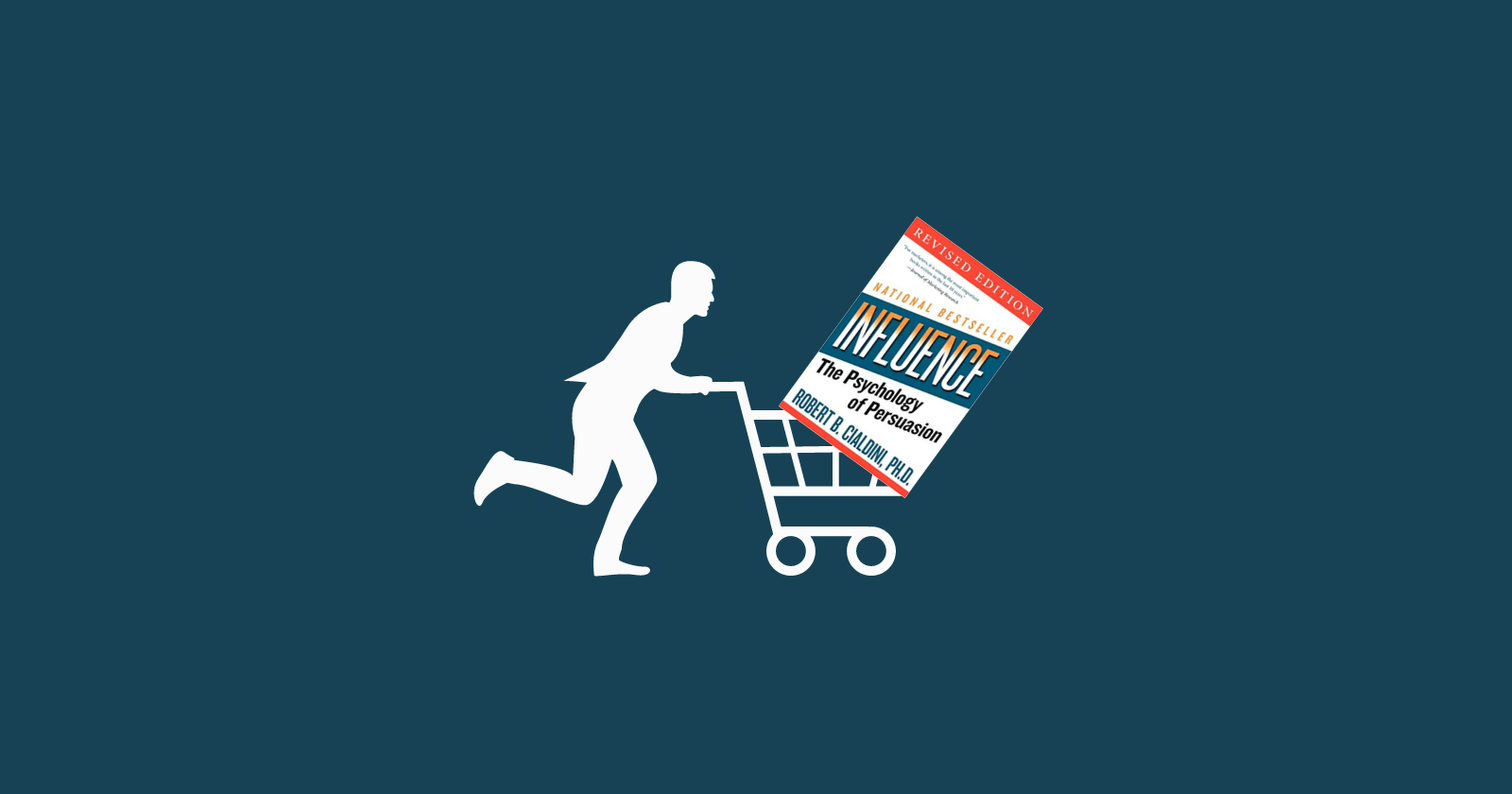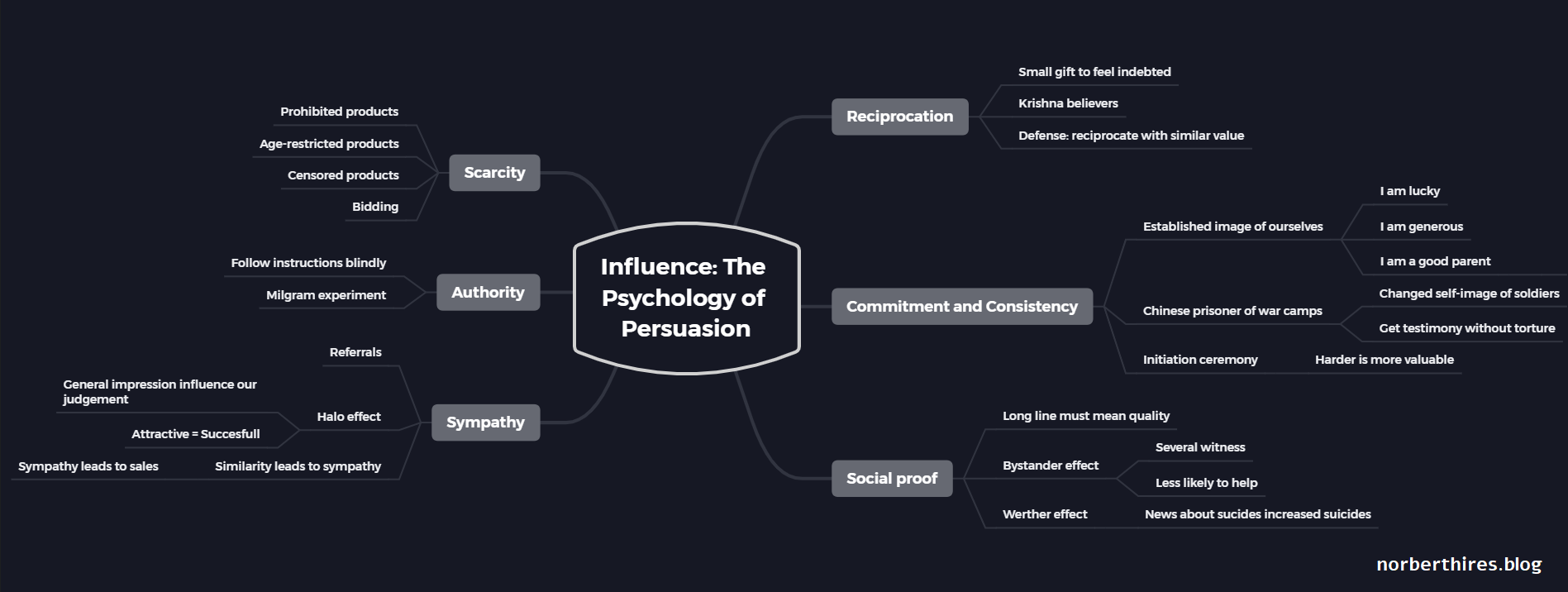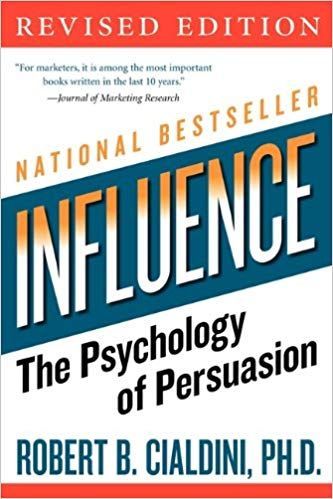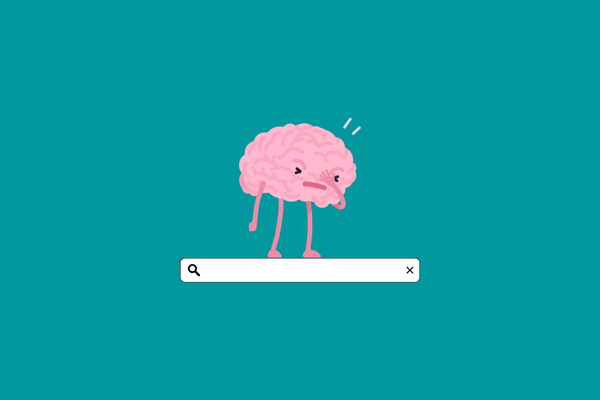Influence Summary: The Psychology of Persuasion by Robert B Cialdini

How do ads affect us? What practices are using salespeople when trying to sell to us? How do they get to donate in the mall against our will? Social psychologist Robert B. Cialdini answers these questions, among others, in his practical yet scientific book.
Influence is a great summary of the most commonly used persuasive techniques and goes one step further: advising on how to prevent them.
The author not only wrote a book on the subject but also immersed himself in practice in the world of professionals living from persuasion. His practical experience serves as illustrative examples in addition to scientific research.
Cialdini collects six principles of the persuasion practices that are used daily, from Krishna believers to car showroom vendors to police investigators.
There are six principles of influence:
- Reciprocity
- Commitment and consistency
- Social proof
- Sympathy
- Authority
- Scarcity
We can encounter the main principles of influence in a variety of ways and situations. Cialdini exposes many of the practices we encounter daily and we would not even think that this is conscious on the part of their users.
1. Reciprocity

By nature, we don’t like to owe to others. It is not just money or high-value items that can make us feel indebted, a coffee, a glass of soft drink or a flower is enough.
The principle of reciprocity was topped by Krishna believers who, with a seemingly kind and selfless practice, amassed a small fortune. Although the case (like most of the examples) occurred in the United States, the technique used is still applied worldwide today.
Krishna believers collected donations in high-traffic places with more or less success, until they recognized the potential of the principle of reciprocity.
At the heart of their tactics was a tiny flower. They continued to try to raise donations in busy places (airports, shopping malls), but they not only wanted to receive but also gave. In front of the unsuspecting passerby, a Krishna believer suddenly appeared and pressed a flower into his hand.
Although the “victim” objected that he did not want the flower, it stayed with him. The believer then stated that this is a gift from the community of Krishna believers for which they do not expect reciprocity but accept donations.
Since the victim wanted to repay the gift anyway, he usually paid several times the price of the flower. This tactic worked for a short time, but once someone experienced it he did not become a victim of the technique again.
People try to exploit the principle of reciprocity in several areas, just think of small corporate gifts, free product samples.
Defense against the principle of reciprocity
Don't fall for small gifts! We should reciprocate the little favors to a similar extent and with a gift of similar value! If we try to reciprocate a gift that seems selfless with a higher value, we have undoubtedly fallen for those who use the principle of reciprocity.
2. Commitment and Consistency

Everyone has an established image of themselves in their minds. Many people do not know that our inner image affects our actions, which is why others are trying to influence it.
If we have decided something in our head, we will cling to it with our teeth and nails. We lose rather than acknowledge that we have lost. Cialdini illustrates the principles of commitment and consistency with countless everyday examples.
Horse betting
Once we bet on a horse (let it be the least likely) that it will run in the first place, we will be more likely to believe it has a real chance of winning.
Christmas off-season
A big question in commerce, especially among toy stores, is how to generate revenue after the Christmas season.
Utilizing the principles of commitment and consistency, traders sought a solution to this problem.
Merchants advertise a certain product, in our case a game, aggressively throughout December. As the message reaches many children, many will specifically ask for that toy for Christmas.
Parents, of course, promise to get the kid a toy, however, when they get to the store they receive the unpleasant news: the toy is sold out.
They are forced to buy other toys, but they also have to keep their promise, so they also buy the featured toy after the holidays.
Chinese prisoner of war camps
In captivity camps, captured soldiers of enemy forces are most often treated inhumanely, but American soldiers captured by the Chinese have been handled differently.
The Chinese authorities did not torture or ill-treat American soldiers. They were psychologically broken. If an American soldier tried to escape, a bag of rice was offered to the one who tossed it.
An essay competition praising the Chinese system was also announced among the prisoners for valuable prizes.
The significance of the technique did not lie in the fact that the Americans betrayed each other or that they wrote an essay praising an opponent. Both events changed the self-image of the soldiers, worrying about the “traitorous, collaborative” labels.
It was easier to extract testimony and information from these soldiers.
All of this without any torture.
University student groups
I never understood what the purpose of the initiation ceremony of different organizations was. New members go through long, seemingly pointless suffering and humiliation year after year.
Cialdini explains that anyone who has made a great effort to achieve certain things is more likely to appreciate it after receiving it.
The harder it is to join a group, the more valuable it is to be a member.
Defending against the principles of commitment and consistency
While commitment and consistency can often have a positive impact on our decisions, it’s worth paying attention to situations where a little commitment costs us a lot in the end.
3. Social proof

Ice cream is delicious when there are so many people lining up for it.
It is more convenient to go with the crowd and follow the decisions made by others. It is easier to believe in social proof than to decide for ourselves.
Following others saves us quite a few decision-making situations during the day, in return, we can be trapped by professionals who take advantage of the phenomenon.
Have you ever wondered what is the purpose of artificial laughter played after jokes in moderately funny series? The principle of social evidence is exploited with it.
If others laugh, it’s probably funny.
The bartenders also build on the social evidence with the glass reserved for the tip. We are more likely to give a significant amount as a tip if there is paper money in the bottle instead of change. That’s why bartenders prefer to put paper money from their wallets into the bottle at the beginning of the shift.
Bystander effect
A much more dangerous form of social evidence is the bystander effect. According to the bystander effect, if a person in need is seen by someone other than us, they are less likely to be helped.
Because of the bystander effect, we can walk past people collapsing on the street, or just in Cialdini’s example, 31 people were able to watch a woman being chased with a knife without anyone calling the police.
Werther effect
The Werther effect is also a negative example of social evidence. A study examined the impact of suicide news published on the front page of a newspaper on the number of suicides.
Only the news significantly increased the number of suicides after the publication of the newspaper.
Horse betting
Horse betting provides countless illustrative examples of the means of influencing.
According to a well-established practice, the bettor plays a poorly performing horse that is insignificant to him for a relatively high amount. Because of this, the other bettors think the guy must know something, so they play the same horse.
Due to the high amounts of money placed on the first horse, the odds on the bettor’s real favorite will increase, so you will play it with a much larger amount before the bet closes.
The professional applying the technique win, while those who go with the crowd lose.
4. Sympathy

The principle behind the success of product demonstrations.
Invite a friend to dinner. You leave unsuspectingly when it turns out you’re not the only guest, in fact, surprisingly many have come.
All-knowing cleaners and other special products were presented during the casual conversation. Although you don’t want any cleaning device, you don’t want to offend the host either, so you succumb to the temptation and buy something.
It was not the product that was sympathetic, but the host.
You didn’t want to hurt the host, and you know he’ll probably get a small share of the profits, too.
This is what the principle of sympathy is about in a nutshell.
Recommendations
Insurance or more expensive financial products often use the recommendation tool.
After closing the deal, the seller will ask you to recommend one or two friends who may be interested in the product you just purchased. He'll find these friends later by referring to you.
Since your acquaintances don’t want to offend you, they don’t immediately slap the phone on the salesperson, who may even close a good deal in the end.
Why is an attractive salesperson more successful?
Partly because a good-looking man/woman is subconsciously more sympathetic than a less-looking colleague. Furthermore, the halo effect also reinforces the phenomenon.
The halo effect is a lie where the impression of a person influences our overall judgment of that person.
We believe that a good-looking salesperson is certainly extremely successful, even though the two qualities have very little to do with each other.
The Power of Similarity
The unknown is frightening, while the familiar to us is reassuring.
What could be more familiar to a person than himself?
When you discover a similarity between you and an unknown, the unknown will suddenly become much more sympathetic.
We like those who are similar to us.
What a coincidence that a used car dealer is
- grew up in the same city as you
- loves fishing
- she likes watches like the one on your hand.
No, it's not a coincidence.
Similarity leads to sympathy and sympathy leads to sales.
Most professional salespeople use the mirror and match technique. They look for (or just pretend) a single little thing in common with the prospect and they already seem more appealing.
We feel like this salesperson understands us even though he just wants to sell.
We vs. They
The whole we vs. antithesis is based on similarities.
School cliques, street gangs, political parties. They are all based on similarities and ideologies of difference from others.
Research at a summer camp proved that the mere fact that the boys were moved to two separate houses divided the company, causing competition and then chaos.
There is something similar in everyone.
When we are confronted with a different opinion on an issue, it is worth looking for another area in which we agree. Cooperation always pays off, while in most cases, no one gets along well with a quarrel.
Thought association
Extreme cases of similarities are when we associate two completely separate things, persons, and judge the other based on one.
Why was the ambassador bringing bad news executed thorough history? Because the bad news was identified with the ambassador.
U.S. weather reporters often receive threatening letters because it was raining on the victim’s wedding day.
Expensive cars are not accidentally advertised with pretty models, and presidential candidates also have a reason to show themselves to the public during the campaign period.
Defending against the principle of sympathy
Let's ask the question:
- Do I like the seller better than I would have thought 20 minutes ago?
Choose the vendor separately from the product to be sold and make the final decision by focusing only on the latter.
5. Authority

We do what they tell us.
In many cases, it is easier to respect the authority of the person giving the order and to follow his instructions blindly than to question his competence.
Think of the biblical Abraham who would have been willing to sacrifice his son just because God asked him to.
Parents, bosses, government leaders.
For a long time, we give them the truth in everything and we have to be very disappointed to question the task, the order, the request.
Numerous examples prove the effect of authority, and it has also been successfully proved by experiments.
Milgram experiment
In an experiment led by Stanley Milgram, subjects were exposed to an electric shock from another person if they gave the wrong answer to a test question.
Subjects believed that the effect of pain on learning was studied in those who suffered an electric shock, although the principle of authority was the subject of the study and the subject examined was themselves.
In addition to the two subjects, there was also a researcher in a white cloak in the room who gave instructions to the individual handling the electric shocks.
Subjects were informed in advance that it was life-threatening to continue the experiment above a certain level, but this was not repeated by the researcher during the trial.
Even above the life-threatening level, most participants gave the subject an order to punish the issue in error, which was done by the majority of the subjects.
The experiment faithfully explains that authority (in our case, the white cloak) can even take us to endanger lives.
However, authority cannot be manifested only in a white cloak.
It could be a suit, an expensive piece of jewelry, or even a title.
6. Scarcity

The application of the scarcity principle without debate is one of the oldest influencing techniques used and has been popular ever since.
Scarcity cannot be limited to inventory.
Although the fact that a good quality product is available in a limited number of pieces can also motivate you to buy, the principle of scarcity goes beyond quantity.
The most common examples of the scarcity principle:
- Prohibited Product: What is banned is effective.
- Age Restricted Product: Prohibited products have always been very popular for a while.
- Censored product: Missed scenes from movies, censored commercials. We now know why these “leaked” videos have such high views.
- Bidding: When we pay a multiple of the real price of a product.
And this is an age-restricted ad that was banned in America:
Summary

Robert B. Cialdini’s book Influence: The Psychology of Persuasion is not just for those who are directly or indirectly affected.
The book helps us identify the illusions that most often influence our decisions and helps us make more informed decisions.
Practical examples lead to a life of avoiding product demonstrations, dismantling salespeople, avoiding Krishna believers from afar, or at least smuggling awareness into these situations.
For me, Influence was a series of AHA moments. Everyday examples made Professor Cialdini’s book readable and scholarly references authentic.




